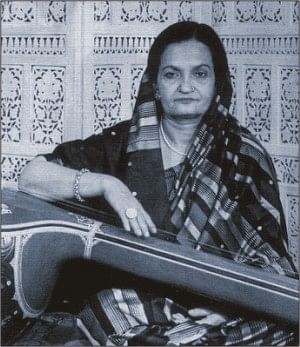Begum Akhtar: The queen of ghazals

Begum Akhtar poured her heart and soul into ghazals. Rightly known as Malika-e-ghazal (queen of ghazals), she had a unique style of singing which few have been able to emulate. In fact one just needs to look at some of her songs to realise her passion and acute observation of human nature. Just eight days before her death on October 30, 1974, she recorded Kaifi Azmi's brilliant ghazal:
Sunaa karo meri jaan un se un ke afsane
Sab ajnabi hain yahaan kaun kis ko pahchaane
(My love, listen to her story
Everyone here is a stranger; none recognises anyone)
Some singers develop a talent for their art even when they hail from less musically inclined families. Begum Akhtar clearly belonged to this category. Born in the small town of Faizabad, Uttar Pradesh, India on October 7, 1914, she developed a taste for music at the age of seven when she was captivated by the music of Chandra Bai, an artiste attached to a touring theatre group.
At her uncle's initiative she undertook training from sarangi exponent Ustad Imdad Khan from Patna. At a later stage she trained under Ata Mohammed Khan of Patiala.
Later, she journeyed to Calcutta, accompanied by her mother, and started learning music from classical stalwarts such as Mohammad Khan and Abdul Waheed Khan of Lahore. Finally she gained musical instruction with Ustad Jhande Khan Saheb.
At the young age of 15, Begum Akhtar gave her first public performance. The show was a resounding success. Many accolades came her way thereafter. Famous poetess Sarojini Naidu expressed her admiration of the ghazal singer at a concert organised in aid of the victims of the Bihar earthquake. Subsequently, Begum Akhtar immersed herself fully into ghazals. She also cut her first disc for the Megaphone Record Company around this time. Her ghazals, dadras and thumris were released in the form of gramophone records.
Begum Akhtar also took a foray into the rough and tumble world of films. Among the films in which she starred were Mumtaz Begum (1934), Naseeb ka Chakkar (1936), Roti (1942) and Jalsaghar (a 1958 film directed by Satyajit Ray).
The great singer also sang in several films but opted out when she chanced to hear singers like Gauharjaan and Malakjaan. She decided to pursue instead a career in classical music.
Begum Akhtar's formidable talent gained wide recognition. She received the Sangeet Natak Akademi award for vocal music and a Padma Shri a few years before her death.
Unfortunately though she was awarded the Padma Bhushan only posthumously.
Though born with the name Akhtaribai Faizabadi, after her marriage to barrister Ishtiaq Ahmed Abbasi, she became known as Begum Akhtar. For five years after her marriage she perforce had to call a halt to her singing career because of her husband's restrictions. Subsequently she fell ill and music was prescribed as the only remedy. In 1949, she staged a return to the recording studios. She sang three ghazals and a dadra at the Lucknow Radio Stationa moving event after which she burst into tears. She then returned to singing in concerts, a practice which lasted until her death.
In the course of her life, Begum Akhtar sang nearly 400 songs, ghazals and other light classical piecesall in her inimitable style. She was also a performer on All India Radio. She mostly composed her own ghazals and most of the compositions were raag based.
Begum Akhtar's end came after her last concert in Ahmedabad. A stickler for perfection, she raised the pitch of her voice as she felt that her singing that day had been below par. As it happened, she had been under the weather that day and the extra demand and stress she put herself under resulted in her falling ill and being rushed to the hospital. She died in the arms of her long time friend Nilam Gamadia who had invited her to Ahmedabad for what turned out to be her last performance.
Despite Begum Akhtar's passing, the ghazal world will remember this doyen.
Compiled by Cultural Correspondent

 For all latest news, follow The Daily Star's Google News channel.
For all latest news, follow The Daily Star's Google News channel. 



Comments